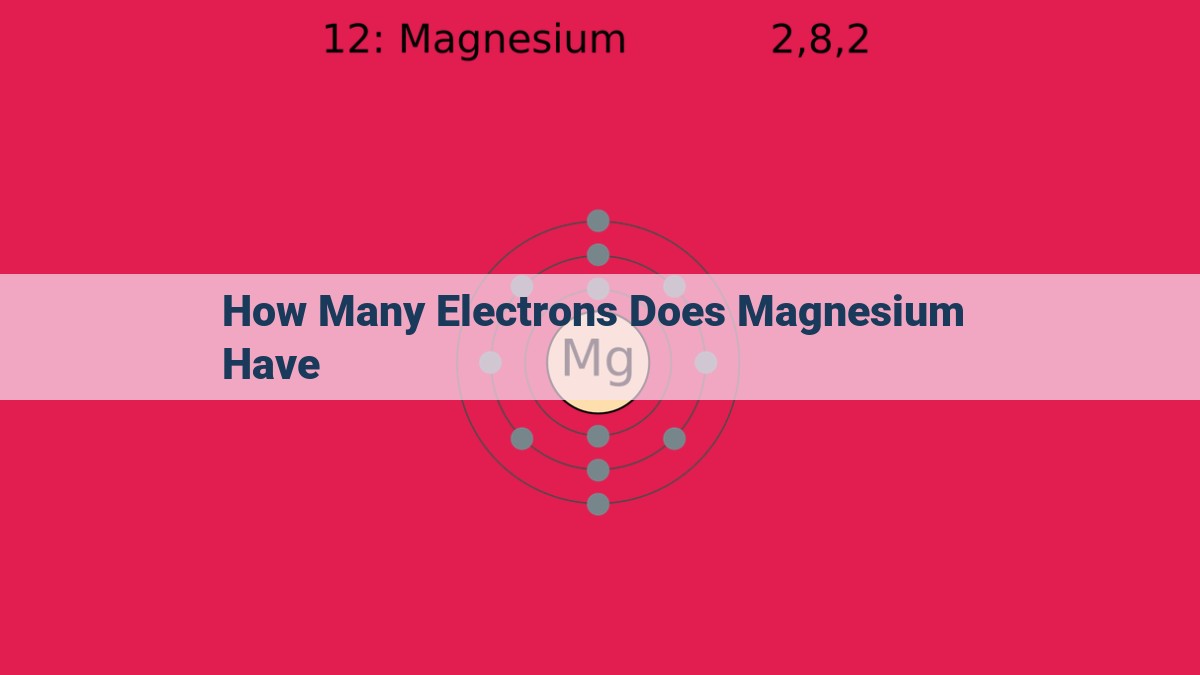Magnesium: Valence Electrons And Chemical Reactivity

Magnesium has 12 electrons. Its atomic number, 12, signifies the number of protons in its nucleus, which is equal to the number of electrons in a neutral atom. According to its electron configuration, 1s²2s²2p⁶3s², magnesium has two valence electrons in its outermost energy level, making it a reactive metal. These valence electrons play a crucial role in chemical bonding, determining magnesium’s ability to form compounds and participate in chemical reactions.
Atomic Number
- Definition of atomic number
- Relationship between protons and atomic number
- Atomic number of magnesium (12)
Atomic Number: The Identity of the Elements
In the vast realm of chemistry, where countless elements dance around, each atom carries a unique fingerprint, an intrinsic property that distinguishes it from all others. This fingerprint is known as the atomic number, a numerical value that holds immense significance in understanding the very foundation of matter.
The atomic number represents the number of protons residing within the heart of an atom, its nucleus. Protons, positively charged particles, are the gatekeepers of the atom’s identity, dictating its chemical properties and behavior. The greater the number of protons, the higher the atomic number, and the more distinct the element.
Take magnesium, a silvery-white metal that plays a crucial role in biological processes. Its atomic number is 12, indicating that every magnesium atom harbors 12 protons in its nucleus. This atomic number is etched into the fabric of magnesium atoms, making them unmistakably different from atoms of other elements.
The atomic number is not merely a number but a fundamental characteristic that governs an element’s place in the periodic table, the iconic chart that organizes all known elements. By arranging elements in ascending order of atomic number, the periodic table unveils patterns and relationships that guide chemists in predicting their properties and reactivity.
Understanding the concept of atomic number is akin to discovering the secret code that unlocks the mysteries of the atomic world. It empowers us to discern the unique identity of each element, unraveling the intricate tapestry of chemistry that shapes our world.
Electron Configuration: A Deeper Dive
In the fascinating world of atoms, electrons play a crucial role, orbiting the nucleus in a structured manner known as electron configuration. This configuration is like an address for each electron, revealing its specific location within the atom’s energy levels.
Each energy level is represented by a number (n), with higher numbers indicating levels further from the nucleus. Within each energy level, electrons occupy orbitals, which are regions of space where the electron is most likely to be found.
The electron configuration of an element is a shorthand notation that describes the arrangement of its electrons in these energy levels and orbitals. Take magnesium (Mg) as an example. Its electron configuration is 1s²2s²2p⁶3s².
Breaking down this notation:
- 1s²: Two electrons in the first energy level (n=1) and s orbital
- 2s²: Two electrons in the second energy level (n=2) and s orbital
- 2p⁶: Six electrons in the second energy level (n=2) and p orbitals
- 3s²: Two electrons in the third energy level (n=3) and s orbital
This detailed representation allows us to understand the specific location and behavior of each electron in a magnesium atom, providing a glimpse into the atom’s electronic structure and its properties.
Valence Electrons: The Gatekeepers of Chemical Bonding
Imagine an atom as a miniature solar system, with a central nucleus surrounded by orbiting electrons. These electrons occupy specific energy levels, arranged in shells and subshells. The outermost shell, known as the valence shell, harbors the valence electrons.
Where Do Valence Electrons Reside?
Like celestial bodies in the outermost orbit of a star system, valence electrons reside in the outermost energy level of the atom. Their proximity to the nucleus makes them the most active and influential electrons, playing a pivotal role in chemical bonding.
The Case of Magnesium: Two Eager Valence Electrons
Take magnesium, an element with atomic number 12, as an example. Its electron configuration tells a revealing story: 1s²2s²2p⁶3s². The 3s² in this notation signifies that magnesium possesses two valence electrons in its outermost energy level.
Chemical Bonding: The Dance of Valence Electrons
Valence electrons hold the key to chemical bonding, the process by which atoms join together to form molecules and compounds. Their ability to participate in chemical interactions stems from their unique properties. They are neither too tightly bound to the nucleus nor too free, making them ideal for forming bonds with other atoms.
In chemical bonding, two or more valence electrons from different atoms come together, sharing or exchanging their presence to achieve a more stable configuration. This exchange or sharing results in the formation of chemical bonds, which hold molecules and compounds together.
In conclusion, valence electrons are the extroverted members of the atomic family, actively participating in chemical bonding. Their presence in the outermost energy level determines an atom’s chemical reactivity and its ability to interact with other atoms. Understanding valence electrons is essential for grasping the fundamentals of chemical bonding and the formation of the myriad substances that make up our world.